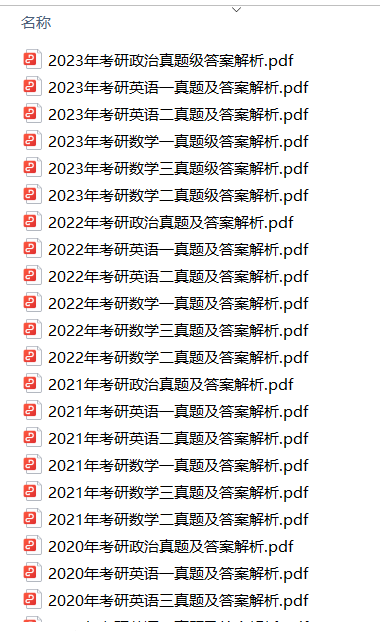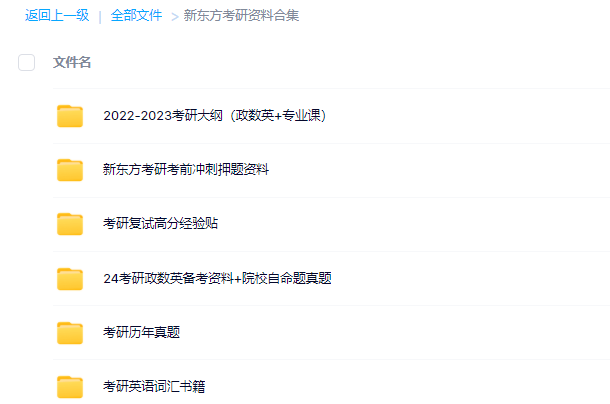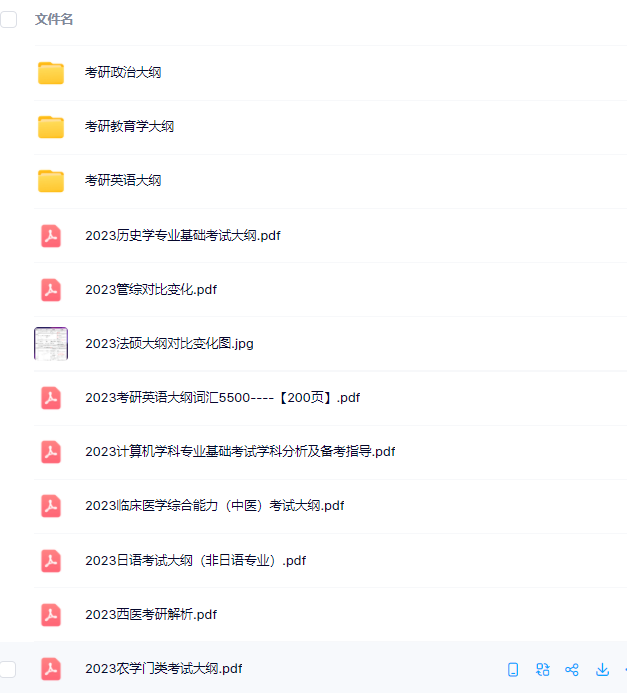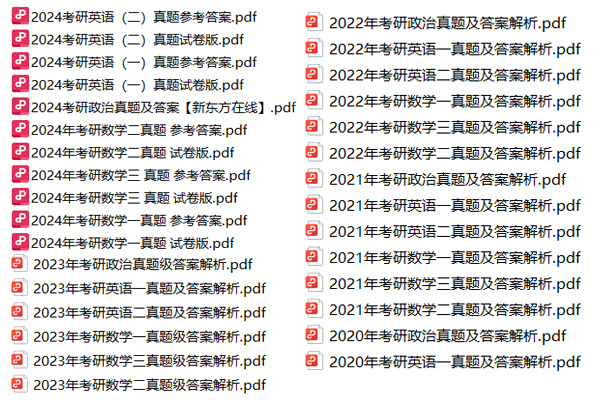特惠-26考研冲刺
特惠-27考研课
双证-在职硕士
免联考-同等学力
26考研-肖八笔记
26考研-时政刷题
26考研-作文押题
26考研-全套真题
26考研-提前估分
保研-路线图
27考研-智能择校
27考研-英语测评
27考研-新大纲对比
热门-计算机择校

扫码加入训练营
牢记核心词
学习得礼盒
2019考研英语二真题及答案:阅读理解部分
2020考研初试时间为2019年12月21日至22日(每天上午8:30—11:30,下午14:00—17:00),考研复习冲刺阶段,往年的真题及答案是考生们复习自测的好帮手,新东方在线考研频道为大家根据考研英语题型整理了往年真题及答案,希望对大家复习有所帮助,祝2020考研学子考研成功~
2019考研英语二真题:阅读理解部分
Section II Reading Comprehension
Part A
Directions:
Read the following four texts. Answer the questions below each text by choosing A,B,C or D.Mark your answers on the ANSWER SHEET.(40 points)
Text 1
Unlike so-called basic emotions such as sadness, fear, and anger, guilt emerges a little later, in conjunction with a child’s growing grasp of social and moral norms. Children aren’t born knowing how to say “I’m sorry”; rather, they learn over time that such statements appease parents and friends—and their own consciences. This is why researchers generally regard so-called moral guilt, in the right amount, to be a good thing.
In the popular imagination, of course, guilt still gets a bad rap. It is deeply uncomfortable—it’s the emotional equivalent of wearing a jacket weighted with stones. Yet this understanding is outdated. “There has been a kind of revival or a rethinking about what guilt is and what role guilt can serve,” says Amrisha Vaish, a psychology researcher at the University of Virginia, adding that this revival is part of a larger recognition that emotions aren’t binary—feelings that may be advantageous in one context may be harmful in another. Jealousy and anger, for example, may have evolved to alert us to important inequalities. Too much happiness can be destructive.
And guilt, by prompting us to think more deeply about our goodness, can encourage humans to make up for errors and fix relationships. Guilt, in other words, can help hold a cooperative species together. It is a kind of social glue.
Viewed in this light, guilt is an opportunity. Work by Tina Malti, a psychology professor at the University of Toronto, suggests that guilt may compensate for an emotional deficiency. In a number of studies, Malti and others have shown that guilt and sympathy may represent different pathways to cooperation and sharing. Some kids who are low in sympathy may make up for that shortfall by experiencing more guilt, which can rein in their nastier impulses. And vice versa: High sympathy can substitute for low guilt.
In a 2014 study, for example, Malti looked at 244 children. Using caregiver assessments and the children’s self-observations, she rated each child’s overall sympathy level and his or her tendency to feel negative emotions after moral transgressions. Then the kids were handed chocolate coins, and given a chance to share them with an anonymous child. For the low-sympathy kids, how much they shared appeared to turn on how inclined they were to feel guilty. The guilt-prone ones shared more, even though they hadn’t magically become more sympathetic to the other child’s deprivation.
“That’s good news,” Malti says. “We can be prosocial because we caused harm and we feel regret.”
21.Researchers think that guilt can be a good thing because it may help______.
A)regulate a child's basic emotions
B)improve a child's intellectual ability
C)foster a child’s moral development
D)intensity a child's positive feelings
22.According to paragraph 2, many people still consider guilt to be______.
A)deceptive
B)burdensome
C)addictive
D) deception
23. Vaish hold that the rethinking about guilt comes from an awareness that______.
A)emotions are context-independent
B)emotions are socially constructive
C)emotional stability can benefit health
D)an emotion can play opposing roles
24. Malti and others have shown that cooperation and sharing _______.
A. may help correct emotional deficiencies
B. can result from either sympathy or guilt
C. can bring about emotional satisfaction
D. may be the outcome of impulsive acts
25. The word “transgressions” (Line 4, Para.5) is closest in meaning to _______.
A. teachings
B. discussions
C. restrictions
D. wrongdoings
Text 2
Forests give us shade, quiet and one of the larder callenges in the fight against climate change. Even as we humans count on forests to soak up a good share of the carbon dioxide we produce, we are threatening their ability to do so. The climate change we are hastening could one day leave us with forests that emit more carbon than they absorb.
Thankfully, there is a way out of this trap-but it involves striking a subtle balance. Helping forests flourish as valuable “carbon sinks” long into the future may require reducing their capacity to absorb carbon now. California is leading the way, as it does on so many climate efforts, in figuring out the details.
The state’s proposed Forest Carbon Plan aims to double efforts to thin out young trees and clear brush in parts of the forest. This temporarily lowers carbon-carrying capacity. But the remaining trees draw a greater share of the available moisture, so they grow and thrive, restoring the forest’s capacity to pull carbon from the air. Healthy trees are also better able to fend off insects. The landscape is rendered less easily burnable. Even in the event of a fine, fewer trees are consumed.
The need for such planning is increasingly urgent. Already, since 2010, drought and insects have killed over 100 million trees in California, most of them in 2016 alone, and wildfires have burned hundreds of thousands of acres.
California plans to treat 35,000 acres of forest a year by 2020, and 60,000 by 2030- financed from the proceeds of the state’s emissions- permit auctions. That’s only a small share of the total acreage that could benefit, about half a million acres in all, so it will be vital to prioritize areas at greatest risk of fire or drought.
The strategy also aims to ensure that carbon in woody material removed from the forests is locked away in the form of solid lumber or burned as biofuel in vehicles that would otherwise run on fossil fuels. New research on transportation biofuels is already under way.
State governments are well accustomed to managing forests, but traditionally they’ve focused on wildlife, watersheds and opportunities for recreation. Only recently have they come to see the vital part forests will have to play in storing carbon. California’s plan, which is expected to be finalized by the governor next year, should serve as a model.
26. By saying “one of the harder challenges,” the author implies that _______.
A. global climate change may get out of control
B. people may misunderstand global warming
C. extreme weather conditions may arise
D. forests may become a potential threat
27. To maintain forests as valuable “carbon sinks,” we may need to _______.
A. preserve the diversity of species in them
B. accelerate the growth of young trees
C. strike a balance among different plants
D. lower their present carbon-absorbing capacity
28. California’s Forest Carbon Plan endeavors to _______.
A. cultivate more drought-resistant trees
B. reduce the density of some of its forests
C. find more effective ways to kill insects
D. restore its forests quickly after wildfires
29. What is essential to California’s plan according to Paragraph 5?
A.To handle the areas in serious danger first.
B.To carry it out before the year of 2020.
C.To perfect the emissions-permit auctions.
D.To obtain enough financial support.
30. The author’s attitude to California’s plan can best be described as _______.
A. ambiguous
B. tolerant
C. supportive
D. cautious
Text 3
American farmers have been complaining of labor shortages for several years. The complaints are unlikely to stop without an overhaul of immigration rules for farm workers.
Congress has obstructed efforts to create a more straightforward visa for agricultural workers that would let foreign workers stay longer in the U.S. and change jobs within the industry. If this doesn’t change, American businesses, communities, and consumers will be the losers.
Perhaps half of U.S. farm laborers are undocumented immigrants. As fewer such workers enter the country, the characteristics of the agricultural workforce are changing. Today’s farm laborers, while still predominantly born in Mexico, are more likely to be settled rather than migrating and more likely to be married than single. They’re also aging. At the start of this century, about one-third of crop workers were over the age of 35. Now more than half are. And picking crops is hard on older bodies. One oft-debated cure for this labor shortage remains as implausible as it’s been all along: Native U.S. workers won’t be returning to the farm.
Mechanization isn’t the answer, either—not yer, at least. Production of corn, cotton, rice, soybeans, and wheat has been largely mechanized, but many high-value, labor-intensive corps, such as strawberries, need labor. Even dairy farms, where robots do a small share of milking, have a long way to go before they’re automated.
As a result, farms have grown increasingly reliant on temporary guest workers using the H-2A visa to fill the gaps in the workforce. Starting around 2012, requests for the visas rose sharply; from 2011 to 2016 the number of visas issued more than doubled.
The H-2A visa has no numerical cap, unlike the H-2B visa for nonagricultural work, which is limited to 66,000 a year. Even so, employers complain they aren’t given all the workers they need. The process is cumbersome, expensive, and unreliable. One survey found that bureaucratic delays led the average H-2A worker to arrive on the job 22 days late. The shortage is compounded by federal immigration raids, which remove some workers and drive others underground.
In a 2012 survey, 71 percent of tree-fruit growers and almost 80 percent of raisin and berry growers said they were short of labor. Some western farmers have responded by moving operations to Mexico. From 1998 to 2000, 14.5 percent of the fruit Americans consumed was imported. Little more than a decade later, the share of imports was 25.8 percent.
In effect, the U.S. can import food or it can import the workers who pick it.
31. What problem should be addressed according to the first two paragraphs?
A. Discrimination against foreign workers in the U.S.
B. Biased laws in favor of some American businesses.
C. Flaws in U.S. immigration rules for farm workers.
D. Decline of job opportunities U.S. agriculture.
32. One trouble with U.S. agricultural workforce is .
A. the rising number of illegal immigrants
B. the high mobility of crop workers
C. the lack of experienced laborers
D. the aging of immigrant farm workers
33.What is the much-argued solution to the labor shortage in U.S. farming?
A. To attract younger laborers to farm work.
B. To get native U.S. workers back to farming.
C. To use more robots to grow high-value crops.
D. To strengthen financial support for farmers.
34. Agricultural employers complain about the H-2A visa for its .
A. slow granting procedures
B. limit on duration of stay
C. tightened requirements
D. control of annual admissions
35. Which of the following could be the best title for this text?
A. U.S. Agriculture in Decline?
B. Import Food or Labor?
C. America Saved by Mexico?
D. Manpower vs. Automation?
Text 4
Amold Schwarzenegger. Dia Mirza and Adrian Grenier have a message for you. It’s easy to beat plastic. They’re part of a bunch of celebrities starring in a new video for World Environment Day—encouraging you, the consumer, to swap out your single-use plastic staples like straws and cutlery to combat the plastics crisis.
The key messages that have been put together for World Environment Day do include a call for governments to enact legislation to curb single-use plastics. But the overarching message is directed at individuals.
My concern with leaving it up to the individual, however, is our limited sense of what needs to be achieved. One their own, taking our own bags to the grocery store or quitting plastic straws, for example, will accomplish little and require very little of us. They could even be detrimental, satisfying a need to have “done our bit” without ever progressing onto bigger, bolder, more effective actions—a kind of “moral licensing” that allays our concerns and stops us doing more and asking more of those in charge.
While the conversation around our environment and our responsibility toward it remains centered on shopping hags and straws, we’re ignoring the balance of power that implies that as “consumers” we must shop sustainably, rather than as “ citizens” hole our governments and industries to account to push for real systemic change.
It’s important to acknowledge that the environment isn’t everyone’s priority-or even most people’s. We shouldn’t expect it to be. In her latest book, Why Good People Do Bad Environmental Things. Wellesley College professor Elizabeth R. DeSombre argues that the best way to collectively change the behavior of large numbers of people is for the change to be structural.
This might mean implementing policy such as a plastic tax that adds a cost to environmentally problematic action, or banning single-use plastics altogether. India has just announced it will “eliminate all single-use plastic in the country by 2022.” There are also incentive-based ways of making better environmental choices easier, such as ensuring recycling is at least as easy as trash disposal.
DeSombre isn’t saying people should stop caring about the environment. It’s just that individual actions are too slow, she says, for that to be the only, or even primary, approach to changing widespread behavior.
None of this is about writing off the individual. It’s just about putting things into perspective. We don’t have time to wait. We need progressive policies that shape collective action (and rein in polluting businesses), alongside engaged citizens pushing for change.
36. Some celebrities star in a new video to
A. demand new laws on the use of plastics
B. urge consumers to cut the use of plastics
C. invite public opinion on the plastics crisis
D. disclose the causes of the plastics crisis
37.The author is concerned that “moral licensing” may
A. mislead us into doing worthless things
B. prevent us from making further efforts
C. weaken our sense of accomplishment
D. suppress our desire for success
38. By pointing out out identity “citizens”, the author indicates that
A. our focus should be shifted to community welfare
B. our relationship with local industries is improving
C. We have been actively exercising our civil rights
D. We should press our government to lead the combat
39. DeSombre argues that the best way for a collective change should be
A. a win-win arrangement
B. a self-driven mechanism
C. a cost-effective approach
D. a top down process
40. The author concludes that individual efforts
A.can be too aggressive
B. can be too inconsistent
C. are far from sufficient
D. are far from rational
Part B
Directions:
You are going to read a list of headings and a text. Choose the most suitable heading from the list A-G for each numbered paragraph(41-45). Mark your answers on the ANSWER SHEET.(10 points)
Five ways to make conversation with anyone
In choosing a new home, Camille McClain’s kids have single demand: a backyard.
McClain’s little one aren’t the only kids who have an opinion when it comes to housing, and in many cases youngsters’ views weigh heavily on parents’ real estate decisions, according to a 2018 Harris Poll survey of more than 2,000 U.S. adults.
While more families buck an older-generation proclivity to leave kids in the dark about real estate decisions, realty agents and psychologists have mixed views about the financial, personal and long-term effects kids’ opinions may have.
The idea of involving children in a big decision is a great idea because it can help them feel a sense of control and ownership in what can be an overwhelming process, said Ryan Hooper, clinical psychologist in Chicago.
“Children may face serious difficulties in coping with significant moves, especially if it removes them from their current school or support system,”he said.
Greg Jaroszewski, a real estate brokers with Gagliardo Realty Associates, said he’s not convinced that kids should be involved in selecting a home—but their opinions should be considered in regards to proximity to friends and social activities, if possible.
Younger children should feel like they’re choosing their home—without actually getting a choice in the matter, said Adam Bailey, a real estate attorney based in New York.
Asking them questions about what they like about the backyard of a potential home will make them feel like they’re being included in the decision-making process, Bailey said.
Many of the aspects of homebuying aren’t a consideration for children, said Tracey Hampson, a real estate agent based in Santa Clarita, Calif. And placing too much emphasis on their opinions can ruin a fantastic home purchase.
“Speaking with your children before you make a real estate decision is wise, but I wouldn’t base the purchasing decision solely on their opinions.”Hampson said.
The other issue is that many children-especially older ones-may base their real estate knowledge on HGTV shows, said Aaron Norris of The Norris Group in Riverside, Calif.
“They love Chip and Joanna Gaines just as much as the rest of us,” he said. “HGTV has seriously changed how people view real estate. It’s not shelter, it’s a lifestyle. With that mindset change come some serious money consequences.”
Kids tend to get stuck in the features and the immediate benefits to them personally, Norris said.
Parents need to remind their children that their needs and desires may change over time, said Julie Gurner, a real estate analyst with FitSmallBusiness.com.
“Their opinions can change tomorrow,”Gurner said.“Harsh as it may be to say, that decision should likely not be made contingent on a child’s opinions, but rather made for them with great consideration into what home can meet their needs best-and give them an opportunity to customize it a bit and make it their own.”
This advice is more relevant now than ever before, even as more parents want to embrace the ideas of their children, despite the current housing crunch.
| |
41.Ryan Hooper | B.says that it is wise to leave kids in the dark about real estate decisions. |
42. Adam Bailey | C. advises that home purchases should not be based only on children’s opinions. |
43. Tracey Hampson | D. thinks that children should be given a sense of involvement in homebuying decisions. |
44. Aaron Norris | E. notes that aspects like children’s friends and social activities should be considered upon homebuying. |
45.Julie Gurner | F. believes that homebuying decisions should be based on children’s needs rather than their opinions. |
G. assumes that many children’s views on real estate are influenced by the media. |
【英语二真题】资料这里有↑↑↑
本文关键字: 英语二真题 考研英语二真题及答案

 资料下载
资料下载
2014年-2025年考研历年真题汇总
发布时间:2024-04-25扫码添加【考研班主任】
即可领取资料包
考研大纲PDF电子版下载-历年(附解析)
发布时间:2024-04-25扫码添加【考研班主任】
即可领取资料包
2026年考研政数英备考资料zip压缩包
发布时间:2024-04-25扫码添加【考研班主任】
即可领取资料包
考研英语大纲词汇5500打印版(基础必备)
发布时间:2024-04-25扫码添加【考研班主任】
即可领取资料包
新东方在线考试模拟题【12套】
发布时间:2024-04-25扫码添加【考研班主任】
即可领取资料包
2026年考研专业课知识点总结
发布时间:2024-04-25扫码添加【考研班主任】
即可领取资料包
新东方考研资料下载地址
发布时间:2023-05-17新东方在线考研资料合集
下载方式:微信扫码,获取网盘链接

目录:
1.2013-2023年近10年政数英真题及解析PDF版(新东方)
2.2013-2023年专业课考试历年真题及解析PDF版
3.24考研复习备考资料大合集:大纲+备考资料+词汇书+考前押题+自命题
资料介绍:
1.2013-2023年近10年政数英真题及解析PDF版(新东方)
 、
、
2.2013-2023年专业课考试历年真题及解析PDF版


3.24考研复习备考资料大合集

3.24考研复习备考资料:考研大纲

3.24考研复习备考资料:政数英备考资料+自命题真题

------------------
考研备考过程中,尤其是专业课部分,参考往年的考试真题,对于我们的复习有更好的帮助。北京大学考研真题资料都有哪些?小编为大家进行了汇总。
北京大学考研真题资料-公共课

北京大学考研真题资料-专业课


以上就是关于“北京大学考研真题资料下载(历年汇总)”的整理,更多考研资料下载,请关注微信获取下载地址。
2024考研公共课必背知识点汇总
发布时间:2023-01-03扫码添加【考研班主任】
即可领取资料包
2013-2023考研历年真题汇总
发布时间:2023-01-03扫码添加【考研班主任】
即可领取资料包
考研英语大纲词汇(PDF可打印)
发布时间:2023-01-03扫码添加【考研班主任】
即可领取资料包
2024考研专业课知识点总结
发布时间:2023-01-03扫码添加【考研班主任】
即可领取资料包
2023考研政治 内部押题 PDF
发布时间:2022-11-16扫码添加【考研班主任】
即可领取资料包
徐涛:23考研预测六套卷
发布时间:2022-11-16扫码添加【考研班主任】
即可领取资料包
考研政数英冲刺资料最新整理
发布时间:2022-11-16扫码添加【考研班主任】
即可领取资料包
23考研答题卡模板打印版
发布时间:2022-11-16扫码添加【考研班主任】
即可领取资料包
2023考研大纲词汇5500PDF电子版
发布时间:2022-07-28扫码添加【考研班主任】
即可领取资料包
考研历年真题(公共课+专业课)
发布时间:2022-07-28扫码添加【考研班主任】
即可领取资料包
考研英语阅读100篇附解析及答案
发布时间:2022-01-07扫码添加【考研班主任】
即可领取资料包
新东方考研学霸笔记整理(打印版)
发布时间:2022-01-07扫码添加【考研班主任】
即可领取资料包
2001-2021年考研英语真题答案(可打印版)
发布时间:2022-01-07扫码添加【考研班主任】
即可领取资料包
考研英语词汇5500(完整版下载)
发布时间:2022-01-07扫码添加【考研班主任】
即可领取资料包
2022考研政审表模板精选10套
发布时间:2022-01-07扫码添加【考研班主任】
即可领取资料包
历年考研真题及答案 下载
发布时间:2021-12-09扫码添加【考研班主任】
即可领取资料包
考研政审表模板汇总
发布时间:2020-06-17扫码添加【考研班主任】
即可领取资料包
近5年考研英语真题汇总
发布时间:2020-06-17扫码添加【考研班主任】
即可领取资料包
考研英语大纲词汇5500
发布时间:2020-06-17扫码添加【考研班主任】
即可领取资料包
2022考研12大学科专业排名汇总
发布时间:2019-11-21扫码添加【考研班主任】
即可领取资料包
2023考研政治复习备考资料【珍藏版】
发布时间:2019-11-21扫码添加【考研班主任】
即可领取资料包
考研英语万能模板+必备词汇+范文
发布时间:2019-11-21扫码添加【考研班主任】
即可领取资料包
考研数学一、二、三历年真题整理
发布时间:2019-11-21扫码添加【考研班主任】
即可领取资料包

添加班主任领资料
添加考研班主任
免费领取考研历年真题等复习干货资料

 推荐阅读
推荐阅读
2025年考研初试结束后,新东方在线为大家整理了:2025年考研英语二真题及答案解析(完整版),供大家参考,同时也为大家提供了电子版文
2025年考研初试结束后,新东方在线为大家整理了:2025年考研英语二真题及答案解析(电子版下载),供大家参考,同时也为大家提供了电子
2025年考研初试结束后,新东方在线为大家整理了:2025年考研英语二新题型真题答案,供大家参考,同时也为大家提供了电子版文档直接下载
2025年考研初试结束后,新东方在线为大家整理了:2025年考研英语二完形填空真题答案,供大家参考,同时也为大家提供了电子版文档直接下
2025年考研初试结束后,新东方在线为大家整理了:2025年考研英语二翻译真题答案,供大家参考,同时也为大家提供了电子版文档直接下载,

 资料下载
资料下载
扫码添加【考研班主任】
即可领取资料包
扫码添加【考研班主任】
即可领取资料包
扫码添加【考研班主任】
即可领取资料包
扫码添加【考研班主任】
即可领取资料包
扫码添加【考研班主任】
即可领取资料包
扫码添加【考研班主任】
即可领取资料包
新东方在线考研资料合集
下载方式:微信扫码,获取网盘链接

目录:
1.2013-2023年近10年政数英真题及解析PDF版(新东方)
2.2013-2023年专业课考试历年真题及解析PDF版
3.24考研复习备考资料大合集:大纲+备考资料+词汇书+考前押题+自命题
资料介绍:
1.2013-2023年近10年政数英真题及解析PDF版(新东方)
 、
、
2.2013-2023年专业课考试历年真题及解析PDF版


3.24考研复习备考资料大合集

3.24考研复习备考资料:考研大纲

3.24考研复习备考资料:政数英备考资料+自命题真题

------------------
考研备考过程中,尤其是专业课部分,参考往年的考试真题,对于我们的复习有更好的帮助。北京大学考研真题资料都有哪些?小编为大家进行了汇总。
北京大学考研真题资料-公共课

北京大学考研真题资料-专业课


以上就是关于“北京大学考研真题资料下载(历年汇总)”的整理,更多考研资料下载,请关注微信获取下载地址。
扫码添加【考研班主任】
即可领取资料包
扫码添加【考研班主任】
即可领取资料包
扫码添加【考研班主任】
即可领取资料包
扫码添加【考研班主任】
即可领取资料包
扫码添加【考研班主任】
即可领取资料包
扫码添加【考研班主任】
即可领取资料包
扫码添加【考研班主任】
即可领取资料包
扫码添加【考研班主任】
即可领取资料包
扫码添加【考研班主任】
即可领取资料包
扫码添加【考研班主任】
即可领取资料包
扫码添加【考研班主任】
即可领取资料包
扫码添加【考研班主任】
即可领取资料包
扫码添加【考研班主任】
即可领取资料包
扫码添加【考研班主任】
即可领取资料包
扫码添加【考研班主任】
即可领取资料包
扫码添加【考研班主任】
即可领取资料包
扫码添加【考研班主任】
即可领取资料包
扫码添加【考研班主任】
即可领取资料包
扫码添加【考研班主任】
即可领取资料包
扫码添加【考研班主任】
即可领取资料包
扫码添加【考研班主任】
即可领取资料包
扫码添加【考研班主任】
即可领取资料包
扫码添加【考研班主任】
即可领取资料包

 阅读排行榜
阅读排行榜
 相关内容
相关内容